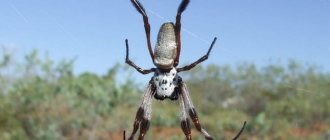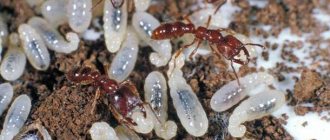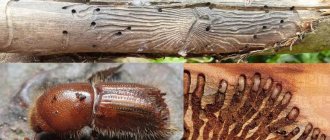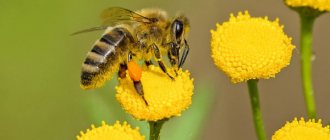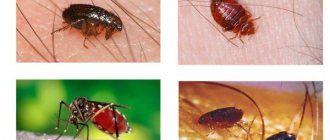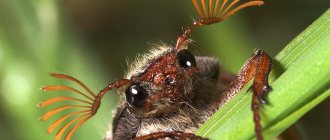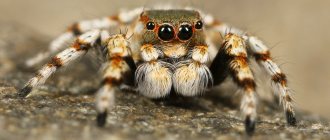The concept of the most terrible insects in the world is different for everyone. Some are frightened by the size of the insect, others by its appearance, others by its toxicity, and still others feel more disgust than fear. These creatures can be scary, vile, disgusting, dangerous. The only missing category is for ugliest insect. Deformity is a distortion of proportions and underdevelopment/overdevelopment of organs. Among species that have undergone millions of years of evolution, there cannot be ugly ones. But in every species there can be an ugly individual.
Human skin gadfly
The human skin gadfly (Dermatobia hominis) is a two-winged insect whose larvae burrow under human skin and become parasites, causing the dangerous disease dermatobiasis. Cases of the disease have been recorded in Japan, the USA and other countries.
In appearance, it is a large fly measuring about 18 mm in length, a yellow head with black eyes, a blue abdomen, legs with an orange tint and transparent wings (like a regular fly).
The main objects of parasitism and mass reproduction for the gadfly are cattle and dogs, but the insect can also infect other warm-blooded animals: pigs, rabbits, cats, sheep, including people.
Human gadfly
Typically these insects attack livestock and people. The female gadfly attaches eggs to mosquitoes, flies and other insects, which transfer the eggs to the host. Body heat causes the eggs to hatch, after which the larvae begin to burrow into the skin.
The larvae cause skin lesions, and the affected area initially looks like a mosquito bite, but then the wound becomes inflamed and abscesses. When the bitten person takes a shower or touches the wound, he can feel the movement of the larvae.
The larvae are usually removed using a simple operation involving local anesthesia. Antibiotics are given after the procedure and the wound heals in less than two weeks.
3) Pliers
These small insects are also dangerous to human life and health. Ticks number about 54 thousand species of their family. Some can provoke terrible diseases, while others are deadly. Despite their miniature size, these bloodthirsty insects wait for their prey among the bushes and grass. Many people say that ticks can live on trees, but they are not able to climb to such a height. Not a single species of tick has wings or high legs for jumping. Therefore, such information about ticks is unreliable. The first type of tick crawls under the skin of the victim and feeds using this method. You cannot pull them out yourself, as his head may remain in the body. The second type of tick prefers to bite through the skin after spending a short amount of time on the body. After a bite from such a tick, a mark remains in the form of a small circle or rash. If the first type of ticks is noticeable by its presence on the body, then with the second you need to be more vigilant. After any trip to nature, you need to carefully examine your body. Symptoms of a tick bite vary greatly. The most common symptoms are: headache, chills, increased weakness, aching joints, vomiting, fever, skin rashes, tachycardia and severe itching. Follow-up diseases from tick bites: Lyme disease, tick-borne encephalitis, anaplasmosis, ehrlichiosis, babesiosis, hemorrhagic fever, typhus and tularemia. Also, any tick bite can provoke lack of air, shock, acute tachycardia and loss of consciousness.
Bumblebee
As children, many of us were told by adults that the bumblebee does not bite, that it is kind and that we should not be afraid of it. This is partly true, because this insect stings incredibly rarely. On the other hand, if it stings, it will lead to very unpleasant consequences. A bumblebee bite is quite painful, and it can be repeated, because this insect does not lose its sting.
One case out of a hundred can lead to serious consequences in the form of loss of consciousness. The cause is an allergic reaction to bumblebee venom. If he bites you on the face, the swelling may not go away for up to 2-3 days.
5) Scorpios
These representatives of arthropods – scorpions – pose no small danger. These arachnid creatures number more than 2,450 species in their family. But out of a huge crowd of varieties, only 25 are deadly poisonous. Among them there are large specimens of 20-21 centimeters and very small ones reaching a maximum size of 12-13 mm. Scorpions are one of the oldest creatures on the planet, and are also not inferior in toxicity to spiders and snakes. Scorpions sometimes attack people by creeping in unnoticed from the back or side. They have very developed vision and therefore in most cases do not approach the victim directly. When I attack its prey, the scorpion thrusts its sting and injects poison. Possessors of a less toxic poison may cause the following symptoms: temporary fever, chills, temperature, headaches, swelling, burning at the injection site, nausea and lethargy. But poisonous representatives cause the following symptoms: dizziness, impaired consciousness, convulsions, tachycardia, asphyxia and sudden changes in pressure. In more severe cases: blood poisoning, paralysis, epilepsy, coma and death.
Hairy caterpillar Coquette moth
Despite its harmless and even attractive appearance, this type of caterpillar is poisonous and dangerous.
The fluffy hairs contain spines through which the caterpillar injects poison into its prey. The poison causes pain, dizziness, and vomiting. The worst thing is that the effect of the poison can lead to complications, and sometimes to a complete stop in breathing.
11
The most disgusting insects
The criteria for disgust vary from person to person, but no one would argue that gray blowfly larvae on a corpse or a cockroach in the kitchen are a pleasant sight. If you approach it from this point of view, then the most disgusting insects will be:
- gray blowfly of the Sarcophagidae family;
- red cockroach/Grussian cockroach (Blattella germanica);
- head louse (Pediculus humanus capitis).
These insects are unlikely to cause real fear in anyone, but disgust and disgust are guaranteed.
Gray blowfly
A large dipterous insect 1-2.5 cm long. The color is gray with longitudinal black stripes on the chest. On the abdomen, black color may be present in the form of transverse stripes, dots or a mesh pattern.
Gray blowfly and red cockroach
Red cockroach
Few people do not know what this synanthropic pest looks like. An insect with a body length of 1.5 cm has a yellow-brown color. On the upper side of the chest there are two stripes of a darker color than the main background. The mustache is long, the head is small.
The female lays eggs in the ootheca, which she carries with her until the offspring hatch. The cockroach has developed wings, but the insect does not like to fly.
Prefers to live in the kitchen. Leads a nocturnal lifestyle, hiding in cracks if you turn on the light. It eats everything it can find. These eating habits are what disgust people. Insects can easily move from the trash can to the table to good food.
The red cockroach comes from South Asia and dies at a temperature of -5°C. For this reason, in northern latitudes it can only exist in heated rooms.
Periplanet Americana
Almost an exact copy of the red cockroach, but 5 times larger. It has a dark brown color without darker stripes. In habits and lifestyle, it is completely identical to its red-haired relative. This species is native to Central Africa, from where it was introduced into many countries.
Head louse
A long, gray insect no more than 4 mm long. The head is very small, much smaller than the cephalothorax. The paws are ideally suited for grasping hair. The head louse feeds on blood. Lives and reproduces on the scalp of humans. Few people would not be disgusted by the sight of these insects crawling on the head of the person sitting next to them.
Beetles
Few people would think of calling even huge beetles scary. They are not at all dangerous to humans and can only be frightening due to their size. Some beetles are larger than the giant water bugs, belostomatids. But all beetles are vegetarians. Most of them are very rare and poorly studied. These insects are actively hunted for sale to collectors. So it's the beetles that should be afraid of people, and not the other way around. Not very scary and largest beetles in the world:
- titan lumberjack (Titanus giganteus);
- Brazilian bigtooth woodcutter (Macrodontia cervicornis);
- Hercules beetle (Dynastes hercules);
- goliath beetle (Goliathus regius);
- stag beetle (Lucanus cervus);
- Ussuri relict longhorned beetle (Callipogon relictus).
The last two beetles also live in Russia, but are very rare.
Giant lumberjack
Inhabitant of the Amazon basin. The insect is so rare that sources even disagree on the size of the beetle. Either his maximum body length is 8-17 cm, or 17-22. The average size of the insects is 13 cm. No one has seen the larva. Comparing the sizes of other longhorned beetles with their larvae, entomologists suggested that the size of the giant lumberjack larva should be 26-34 cm.
Giant woodcutter
The color of the beetle is dark brown. Mustache half the length of the body. Leads a nocturnal lifestyle. During the day it hides in hollows, forest litter, and rotten stumps. The imago does not eat at all for 3-5 weeks of its life. The larva feeds on rotting plant organic matter.
Brazilian bigtooth lumberjack
Habitat: tropics of South America. The maximum length is 17 cm. Almost half is made up of long, serrated and curved mandibles. Development can last up to 10 years in the larval stage. The length of the larva is 21 cm.
Hercules beetle
The range is again Central and South America. Lives in humid forests. The length of the largest recorded beetle is 17 cm. On average, it is 12.5-14.5 cm. Half of the length is accounted for by a pair of horns located in a vertical plane. One, longer, on the pronotum. The other one is shorter, on the head. The length of females is 8 cm. There are no horns.
Color of the male: head and pronotum black, shiny; The color of the elytra varies. This depends on air humidity and the elytra can be colored yellow, olive-brown, yellow-olive.
The imago is starving. The larva feeds on rotten wood. The period of the larval stage is 1.5-2 years. By the end of development, the larva reaches a length of 18 cm and a weight of 100 g.
Brazilian lumberjack and Hercules beetle
Goliath beetle
Habitat: Equatorial Africa. The average size of males is 8.5-9.6 cm. Maximum length is 11.6 cm. Females are 5-8 cm. The color is black with a white pattern on the upper part of the body. An adult insect lives for six months. Leads a daily lifestyle. It feeds on tree sap and rotten fruit.
Stag beetle
The largest European beetle. Range: Europe, Western Asia, north-west Kazakhstan, North Africa. The size of the insect can vary greatly depending on its habitat. Average measurements: male 4.5-8.5 cm, female 2.5-5.7 cm. Maximum recorded size 10 cm.
The head is very large, flattened. The male's mandibles are long and well developed. In the female, the mandibles are almost invisible. The color is brown, the head and pronotum are darker in tone. The pronotum and head of the male occupy more than half of the total length. In the female, the relationship is the opposite: the abdomen is longer than the head and pronotum.
Ussuri relict barbel
Other names:
- relict barbel;
- Ussuri relic woodcutter;
- relic woodcutter.
Keyword: relict. The insect is a relic of the Tertiary period and the only representative of the tropical genus Callipogon. Lives in the Amur region in the Far East.
Males 6-11 cm, females 6-9 cm. Habitat: broad-leaved and mixed forests. The development time of the larvae is 4-6 years. They develop in drying deciduous trees. They feed on rotting wood.
An adult insect drinks tree sap. Beetles are diurnal. The color of the body is black, the elytra are brown-chestnut.
Due to logging and poaching, it is classified as an endangered species and is listed in the Red Book.
Cockroach - rhinoceros
Lives in Australia. The second name is giant burrowing cockroach . In appearance it looks more like a beetle, but belongs to the cockroach family. This is the heaviest type of cockroach on the planet. Its weight is about 35 grams. But, despite their rather disgusting appearance, some connoisseurs keep them at home, in terrariums. They are clean and do not have a nasty smell. Moreover, they live up to 10 years . Favorite food: fallen tree leaves.
Army ants
There are a huge number of ant species in the world, and many of them are very dangerous. These include army soldier ants, which are a specialized caste of worker ants and termites. The lack of vision only makes them more dangerous, because they attack anything that has flesh and blood - a fly, an elephant or a person. These fighters move in colonies and do not build anthills, so getting in their way will be a big deal. This type of ant has a large body, reaching 3 centimeters. They are armed with powerful, long mandibles that easily rip open flesh. Having made a hole, the ants climb into the wound and continue to destroy tissue, which causes incredible pain to the victim. They were even figuratively called “living death.” A colony of such ants could chew up an elephant in a week, and that would be a lot for a person to eat in a day.
The most terrible moth in the world
It is not the moth itself, a native of Denmark, that inspires fear, but its formidable caterpillar, called the Shy Moth. From a distance, the bright yellow caterpillar looks like a porcupine or a sponge due to the islands of spiny hair covering its 50 mm body. Up close, the caterpillar is frightening with its double row of jaws, and with the arrival of autumn it becomes a harmless pupa.
Infestations of the world's worst moth are causing significant damage to Denmark's beech forests. For humans, contact with caterpillar hairs results in the appearance of an allergic rash, which is very painful.
Killer bees
The killer bee (aka Africanized bee) looks very similar to a regular bee, but this killer insect tends to attack more and more often, which is why they pose such a huge threat to humans. They can create nests in places such as car tires, boxes, barns, carriages, etc.
It is known that if these bees are disturbed, they are capable of chasing people at a distance of up to 4-5 km.
If these aggressive bees start chasing you, it is recommended to quickly run away, making zigzag movements. Never try to hide from them by jumping into the water, because they will simply wait for you to come out.
Hawkmoth resembling a hummingbird
You can look at this living creature for a long time, but still not understand whether it is a hummingbird or an unusual insect. In fact, the second is true - this is the hawk moth Hemaris thysbe or the glass hummingbird, whose wingspan is 38-50 mm. When feeding with nectar, the insect incredibly looks like a tiny bird, and many people think so when they see it. The similarity in size, diurnal lifestyle, and behavior cause great confusion during the identification of these insects in the natural environment. The butterfly feeds through a long proboscis, which the rest of the time is coiled under its head. These unusual insects live in North America, and the best time to observe them is in the spring.
Common earwig
The insect is found in Europe, as well as in Russia. Only about two centimeters long. The second name is two-tailed, it received because of the forked tail at the end of the body. It does not pose a great danger to humans, as it rarely bites, mainly for defense. Eats both animal and plant foods.
By the way, this insect has been disliked since ancient times. From there came the belief that an earwig can get into a person’s ear and deprive him of his hearing by damaging his eardrum, but in fact this is just a myth.
6) Malaria mosquito (sandfly)
Parasitic malaria mosquitoes pose a significant danger to people. In their genus they have about 10 subspecies of their family. Basically, Indian and African species are more dangerous. These small dipterous insects are carriers of parasites and infections. The malaria mosquito goes through a whole cycle of infection. Initially, he becomes infected with Plasmodium from a human host. The malarial plasmodium then multiplies inside the mosquito. Then the mosquito, after 5-10 days, becomes the carrier of the infection and its main source. There are mosquitoes that carry not only human, but also animal plasmodium. The most dangerous diseases transmitted by malaria mosquitoes are: malaria, threadworms, yellow fever and encephalitis.
Japanese mountain leeches
These are leeches that do not live in water. But they love to suck blood just like their aquatic counterparts. It lives mainly in trees, and from there it can jump on its prey and, gnawing through clothing, get to the skin. In addition, it is very painful; the appearance of a mountain leech is not at all aesthetic. And like any blood-sucking insect, it is a carrier of diseases.
Creepy and terrible
When creating living beings, nature provided a lot. And often the appearance of the animal already indicates that the meeting will not bring anything good. One of these signs, for example, is bright coloring. But sometimes terrible forms and disgusting appearance serve only to scare off enemies. True, this rarely happens. Below is a list of insects that are quite harmless to humans, although they look quite repulsive.
Giant long-legged grasshopper
The kitten-sized grasshopper lives in the forests of Malaysia. Despite very long legs, he jumps poorly. Moves very slowly on the ground. It is completely harmless to humans. Although, in defense, it can bite.
Horned hazel devil
The creature, completely harmless to humans, looks so creepy that it could be an excellent participant in a horror film. And indeed, it resembles a devilish creature: thorns, horns, growths, bright coloring. By the way, the horns on the caterpillar’s body can grow up to 15 centimeters! But all these frightening details are only to scare away enemies.
Giant stick insect
This Australian resident is the best master of camouflage. Pretending to be a twig or leaf is not a problem for him. The insect will not cause harm to human health. But still, you shouldn’t touch it. The insect defends itself in a very specific way: it sprays the threatening object with vomit, blood or feces. So it's better to avoid it.
Rhinoceros cockroach
This is a completely disgusting creature. But not only its appearance is frightening, but also its size. An adult can reach 10 centimeters in length! The insect will not cause trouble to humans. Although, if threatened, it begins to hiss. Sometimes it can even bite.
Goliath beetle
Another frightening representative of the animal world. Despite its large size and weight, up to 100 grams, it is an absolutely peaceful creature that will not cause harm unless threatened.
Brazilian humpback
These are small insects whose distinctive feature is the most incredible shaped outgrowths located on the back. They can be in the form of horns, ridges, balls, spikes, horns, etc. These “structures” sometimes exceed the size of the humpback itself. Actually, because of them, this insect got its name. Meet the most unpleasant insects on our planet. Brazilian humpback or Bocydium globulare
Evolution made the Brazilian humpback so ugly for a reason. The surreal appearance of the insect scares away predators. Quasi-bumps in the form of antennas, at the end of which there are balls similar to eyes, are actually chitinous layers that protect the humpback from attacks by predators. Yes, these are the harsh realities of the wild. The uglier and scarier you look, the more likely you are to survive.
Camel spider (salpuga)
The giant camel spider lives in Egypt and other eastern countries. Despite all the myths and rumors, in reality this insect is only 15 cm in size. In fact, the camel spider is not even a spider, but a salpuga, which is a separate order belonging to the class of arachnids. The salpuga's body consists of an abdomen and cephalothorax with large chelicerae, which produce a specific sound - chirping. The camel spider is also called the Egyptian giant or wind scorpion. Camel spiders are very fast and can run at speeds of 16 km/h. These desert dwellers have strong jaws that measure a third of their body length. For humans, a salpuga bite is not fatal and not very painful. Like other types of spiders, the camel spider also injects digestive juices into the body of the victim. The camel spider became an Internet sensation during the military operations in Iraq. Then the networks began to talk about the special bloodthirstiness of these insects and publish frightening photographs, which created the impression that the salpuga was half the size of an adult.
Silkworm Calleta
The caterpillars of this butterfly are carriers of a wide range of colors, as well as very dangerous-looking hair. Most predators prefer to stay away from them. The butterfly lives in the southern part of the USA. It is worth noting that the color of the caterpillar changes depending on age and some environmental factors. The caterpillar feeds mainly on Mexican legumes that grow in Mexico City, Texas and Arizona.
People are always attracted to everything unusual and frightening. And insects were no exception. The most terrible and frightening representatives of this class served as the prototype for the heroes of creepy stories or horror films.
Giant water bugs (lat. Belostomatidae)
0 Source:
We've all heard about bedbugs and how some of them smell terrible and others feed on human blood, like the bed bug. This is true. What do you say when you learn that there are bedbugs up to 15 centimeters in length living in the world? True, they won’t climb into your bed, but while swimming in the pond they may accidentally bite you. We are talking about giant water bugs.
7.
Gadfly (family oestridae)
Most species can be found in Central and South America, some throughout the world.
There are dozens of varieties of gadflies, all of them are parasites and have a high degree of attachment to a certain type of host, having characteristic names: horse gadfly, sheep gadfly, and so on. Guess what other gadfly there is? That's right - human. They all have a different and well-thought-out reproductive cycle, each of which, however, ends in a fat one and a half centimeter maggot grown in living flesh. And this maggot eats around itself. Horse gadflies, for example, lay eggs in the grass. The horse eats grass, and with it eggs. Which then develop in the warmth of the horse's mouth into larvae and begin to move inside the horse's digestive tract, for which they sometimes have to gnaw passages in the animal's tongue. They all meet in the stomach, form honeycombs and gain weight. When the time comes to become a fly, they simply unhook and then pass out with their feces.
The human gadfly lays eggs on various kinds of midges and mosquitoes, which theoretically can land on a person. When the blood-sucking vector does its job, the eggs fall off onto the skin and, thanks to body heat, begin to mature. The resulting larva reaches the nearest area of suitable skin and begins to gnaw inside under the skin. Where she will live and eat.
Next there will be a video in which one of the larvae is pulled out. There is no need to watch it. It's just disgusting. Here's the creepiest part. The larva can grow anywhere on your body, it just depends on where the egg lands. For example, you might get a fatty, wormy thing in your tear duct. Or in the brain. This is known because it has already happened.
A gadfly larva poking around your brain and eating your thoughts.
Kissing bug
Often this type of beetle, which was discovered back in the 19th century by Darwin, lives in North and South America. They usually feed on the blood of vertebrates. The insect is also different in that it can carry infection caused by a deadly disease (Chagas). At the site of the bite by this insect, swelling first occurs, and then the infection further spreads to the heart and intestines. As a result, a person may even die. About 50,000 people a year die from kissing bug bites.
4) Wandering Spider
Many species of spiders are dangerous to human life, but the most poisonous species is listed in the Guinness Book of Records - the “Brazilian Wandering Spider”. This representative of arthropods contains the most toxic poison in the world. Its size ranges from 15 to 16 centimeters, and its body is covered with brown-gray hair. This insect is capable of running quickly and climbing trees. It attacks a person solely for the purpose of self-defense. Any bite from a wandering spider is fatal. At the moment of a bite, its venom instantly spreads into the lymphatic system and then enters the bloodstream, which in 83-85% leads to cardiac arrest. Also, when bitten, the muscles are paralyzed and asphyxia occurs. The bite of a wandering spider itself is not very painful, but the consequences are particularly tragic. There is an antidote for its poison, so the mortality rate is currently low.
The most terrible caterpillar in the world
Nature has endowed the large harpy, a butterfly in the caterpillar stage, with an unusual appearance designed to scare away enemies. To survive in a world of predators, the caterpillar freezes, becoming invisible among the lush greenery. Characteristics of the forest inhabitant of North America, Europe and Siberia:
- the individual remains at the caterpillar stage from July to September;
- The body length of an adult animal reaches 6 cm;
- the back of the green creature is decorated with a purple diamond, the sides are decorated with white spots;
- the end of the body is equipped with a fork-shaped outgrowth, which rises in case of danger;
- The head of the future insect is crowned with two eye spots, and underneath them is a gaping mouth.
The strange facial expressions of the individual, capable of imitating more dangerous insects, are intended to scare away predators, and the semblance of a “face” looks simply terrifying. If you touch the most terrible caterpillar in the world of insects, its “face” will turn towards you. If your attack continues, you'll be shot with formic acid from the little horns adorning the creepy creature's back.
7) Rat flea
One of the most dangerous types of insects are rat fleas. They are the main parasites and carriers of terrible diseases, including the plague. They live on the bodies of rats and gerbils in tropical and subtropical climates. Externally, the rat flea is 2-3 mm long. In appearance, rat fleas are no different from their other species. They mainly reproduce and feed off of the rat's body. A flea bite for a person is accompanied by severe itching, redness, swelling and suppuration of the wound. An allergic reaction also often occurs. A repeated bite of a rat flea entails the following consequences: long-term headache, inflamed lymph nodes and the formation of ulcers on the body. In addition to the symptoms of the bite, fatal diseases also develop: rat typhus, plague bacillus, rat chain worm, salmonellosis, brucellosis, anthrax, tularemia, plague and encephalitis.
 Tsetse fly
Tsetse fly
The African tsetse fly is also a dangerous carrier of the disease. In its genus there are approximately 23 species of its family. Externally, the tsetse is no different from an ordinary fly with the exception of a small proboscis. It lives in Africa and among the Sahara deserts. Tsetse is a carrier of trypanosomiasis, which leads to many diseases, including the main one - sleeping sickness. These flies infect a huge number of people with this disease every year. She feeds from her proboscis and chooses not only people as her prey, but also animals. Once bitten, tsetse fly parasites cause: confusion, lack of sensation and poor coordination. Animals with the parasite have symptoms such as fever, anemia and weakness. In any case, if you do not treat the parasites of this fly, it can lead to death.
Top 5 dangerous insects in Russia
You can comfort yourself with the thought that almost all the insects on the list are in distant countries. But our rating was compiled not to calm vigilance, but to focus attention on possible danger. There is also something to watch out for in Russia.
You can start with cockroaches, which for some are habitual neighbors. At the same time, the simplest Prussian is a carrier of numerous infectious diseases, such as dysentery, diphtheria and others. In addition, moving in dirty basements and entrances, red cockroaches carry eggs of all kinds of parasites on their bodies, which are then evenly distributed throughout the living quarters.
Also in Russia there are the above-described bullet ants. Simple ants, like cockroaches, spread all kinds of infections, so the threat should not be underestimated.
Another invisible neighbor of people is fleas. The animal's bite is quite painful and can cause allergies. In addition, fleas carry all sorts of parasites such as tapeworms and bartonellosis disease. Insects reproduce very quickly, bite often and enter the house not only with animals, but even on the soles of shoes.
Midges or humpback gnats, which are less than 5 mm in size, are not as harmless as they seem. They aggressively attack people and animals, causing swelling at the site of the bite with their venom. Sometimes an allergy to midge bites manifests itself in unbearable itching and a temperature of 40 degrees. If you had to deal with midges in the tundra, then you need to be prepared for plague, tularemia and other terrible ailments.
And for a snack there are mosquitoes, which not only bother you with their squeaks at night, but also leave quite painful marks on the body. Malaria mosquitoes claim the most human lives per year and are the most dangerous animals on Earth, according to statistics. Mosquitoes carry malaria, yellow fever, dengue, encephalitis, Zika fever and much more. Malaria alone claims up to 200,000 lives a year. Unfortunately, Russia is home to 10 species of malaria mosquitoes. They live comfortably in the European part of the Russian Federation and Western Siberia. The rating turned out to be very unpleasant, but its main task is to protect readers from the risks associated with communicating with wild nature.
Gadfly
We are very familiar with the common gadfly, which can bite painfully, but nothing more. But there is a special type of human skin gadfly, the danger of which lies in its parasitic larvae. Such gadflies live in South and Central America. The female of such a gadfly lays eggs on the skin of humans or other mammals. The hatched larva gnaws through the skin and settles under it for two months. A person is even able to feel the movement of the larva under the skin. When the larva fully matures, it leaves the body of the hospitable host, who at the moment of parting feels not the most pleasant sensations. The unsightly appearance and such indelicate behavior of this larva put it among the most unpleasant insects. Another representative of the gadfly is the nasopharyngeal gadfly, which is one of the largest flies. But it is most dangerous for sheep. The females of this gadfly inject up to 40 larvae into the nasopharynx of a poor sheep at a time. Then for six months they feed on the surrounding tissues of the host, causing sheep esterosis.
Hands to Feet
Lice
During the process of evolution, lice lost the ability to fly, as they completely switched to a parasitic lifestyle. Ectoparasites settle on the body of an animal or human and feed on blood and skin particles.
Lice are very dangerous as they are carriers of deadly diseases. Following basic hygiene rules will save you from the danger of such an unpleasant phenomenon as lice.
16
Army soldier ants (Eciton burchellii)
Found in the Amazon riverbed. There are also families living in Asia and Africa, but these are the best known. Now it will not surprise you that, firstly, these ants are huge - with soldiers reaching one and a half centimeters in length, and secondly, they have massive, powerful machete-like mandibles the size of half the body. They are known primarily for the fact that they disassemble into cogs all living things that they come across on their way, regardless of size. They are also completely blind, which significantly worsens the overall picture. They are called army because the entire colony, ranging from a million insects, is a 100% mobile battalion. They do not build permanent anthills like their brothers, no, they make a halt just long enough for their queen to lay thousands of eggs while the soldiers disperse around the area in search of food (anything that moves in one way or another is good for food). Then the eggs hatch and the army continues on its terrifying path. Just like the word “killer,” nature takes the words “frightening” and “army” very, very seriously. The ants carefully raise their larvae and continue onward as an almost solid mass of insect death and terror, moving steadily and efficiently across the jungle floor, flaying alive and dismembering any living creature that was too stupid, slow or simply sleeping in their path. We are not talking about painful stings or ballistic acid here, no, this horror is of a much more primitive nature - when a wave of hundreds of thousands of ants covers you and tears you to pieces with huge incredibly strong jaws, being completely blind to understand the size of the victim, assessing absolutely everything in the way is a threat to the existence of the colony. There are documented accounts of horse-sized animals being attacked and consumed by these ants. Stand next to the horse and think about what it means to you. Army ants are masters of completely organic architectural designs. For the benefit of the colony, ants use their bodies to create almost any structure imaginable, clinging to each other and forming protective walls from the elements, bridges to overcome obstacles, you name it. No living creature in the world does this except them. Fortunately, they cannot yet form a catapult from their bodies and launch themselves at the victim.
If you are overly squeamish or have a weak stomach, or are worried about your psyche, perhaps it is better for you not to read further.
Giant hornet
Giant hornets live in many places in Asia: in China, India, Nepal, Korea, Japan, and even in our Primorsky Territory, such individuals have been noticed. The length of these giants can exceed 5 centimeters, they have very powerful jaws and an impressively long (6 mm) stinger, with which they can easily pierce human skin. Such an aggressive predator attacks for no particular reason, and fighting it off without outside help is very difficult. When attacking, the hornet repeatedly uses its sting, injecting a new portion of poison with each injection. It is very painful and also destroys muscle tissue. One Japanese entomologist, who was attacked by such a hornet, described its bite as the impact of a hot nail. Every year, 30-70 people die from giant hornet bites.
Africanized honey bee (Apis mellifera scutellata)
Found in South and Central America and the American Southwest. Do you know how you can spot one of them? NO WAY! There is no way to visually distinguish an Africanized bee from a regular European one. You can, however, easily sense the difference by their behavior. Regular bees will give you about 9-10 seconds of being close to the hive before they consider you a threat and attack. Thus, it is quite easy to pass them without incident. And even if they chase you, after 100 meters they will decide that they have driven the enemy far enough and will return back.
Africanized bees don't do such nonsense. They will give you no more than half a second of being at too close a distance, after which they will decide that the time has come to deal with you in such a way that it will not seem enough: the entire hive rises into the air - tens, maybe hundreds of thousands of angry bees. And you will run, waving your arms, sobbing, screaming and throwing dirt on yourself for about a kilometer, until they fall behind you. A little more scary: Africanized bees owe their existence to science. Warwick Kerr bred them in Brazil in the 50s of the last century by crossing the European bee with the African one. He wanted the bee to be able to live in the jungle. He got bees that live in swarms of hundreds of millions of individuals, control territory, are insanely aggressive and kill anywhere from several tens to several thousand people every year. And yes, capable of living in the jungle. And after they left their habitats and moved north, it turned out that they could exist perfectly not only in the jungle, but also in the desert.
Scolopendra
A very hard-hitting armored arthropod lives in regions with different climates, but especially prefers the tropics. Various types of centipedes are found in deserts, limestone mountains, and forests. Some centipedes can also be observed in human homes, especially in the southern regions. In the climatic conditions of Russia, the insect grows from 2 to 10 cm.
All millipedes are predators and feed on small insects. The giant scolopendra, which lives on the South American continent and reaches 30 cm in length, can even eat a frog. The insect's body consists of segments, each of which has a pair of legs. The first pair of limbs plays the role of poisonous jaws, with the help of which the centipede grabs prey. Centipede venom is not fatal to humans, but can cause swelling and severe pain.
